Second-year’s project hopes to set international quality standards for photovoltaic connectors
While much of the research done on campus will make differences in the real world, one student is working on a project that could have international repercussions. Olga Eliseeva, a second year student, is working on a research project that will hopefully result in the creation of international quality standards for photovoltaic (PV) connectors.
PV connectors are the pieces of equipment that connect solar panels to a grid. Over the summer, she started small by concentrating on the wire itself. She would spend from 9 a.m. to 5 p.m. working in a lab, operating machines that create an accelerated environment. There were different types of exposures, such as UV rays, heat, water and salt. Each type of environment was constructed by a specially built machine, such as a QUVb for UV rays, or Q-fogs for salt.
After Eliseeva completes the work on the wire, she’s planning on moving onto stage two of her project, which involves exposing the connectors attached to the wire to environmental simulations.
“[We plan to look] at how the voltage actually changes. How much resistance it gains overtime,” Eliseeva said.
What she is specifically looking at is the insulation in the wires and how the elements affect them. For now, however, she’s been reading large amounts of literature on the topic.
“I’m taking my spectra and translating it into something numerical, something that can be calculated, something that can be worked with,” Eliseeva said. “Right now, we have pictures, and we need the numbers out of [the pictures].”
In order to do this, she has to use analytical computer programs, and has to become familiar with some computer programming. Additionally, to promote the idea of creating an international standard, she plans to send samples around the world, in order to see if the idea could gain momentum.
She’s been meeting with Underwriter Laboratories (UL), which sets the standards for electronic equipment in America. If UL were to approve her standards, they would be sent to the Institute of Electrical and Electronics Engineering (IEEE). IEEE contains the board of directors and would decide whether to adopt her proposed standards for the entire globe.
She plans to do a presentation for Intersections, a symposium where students present their research, in the winter. While the project won’t be finished anytime soon, she has planned out the last step.
“Step three would be taking the wires [and] the connectors and attaching them to an actual solar cell and putting them out in the real world. So putting an actual load [and] an actual resistance and seeing what happens,” Eliseeva noted.
She emigrated from Russia when she was five with nothing but her mother, her brother and a bag of clothing. The move was big for her, especially due to the fact that she didn’t know English at the time. The reason she came to Case Western Reserve University was because of her interactions with the people on campus when she visited. She was presenting research that she had been doing since her junior year in high school and was having trouble finding her way around.
She said, “Officer Mark found me frantic, freaking out. I had no idea where I was going and he directed me to where I needed to go and gave me a giant high-five. The support that he gave me, it helped a lot.”
She’s attempting a B.A. in Material Sciences and Engineering, focusing in biology, and planning to get a masters degree within four years. When she’s not doing work for classes, she’s busy as vice president of the Case Ballroom Dance Society and of the Undergraduate Materials Society. Additionally, she’s a member of Sigma Psi and Gamma Sigma Alpha.
In the future, however, she plans to move toward a biological focus. Eliseeva is especially interested in nanoparticles that would be used for medical treatments. For now, she hopes her project pans out and that she’s able to propose standards for PV connectors that would one day be used worldwide.

Kushagra Gupta is a cognitive science and biology student and is working towards a masters in medical physiology. He's served as The Observer’s The Director...

